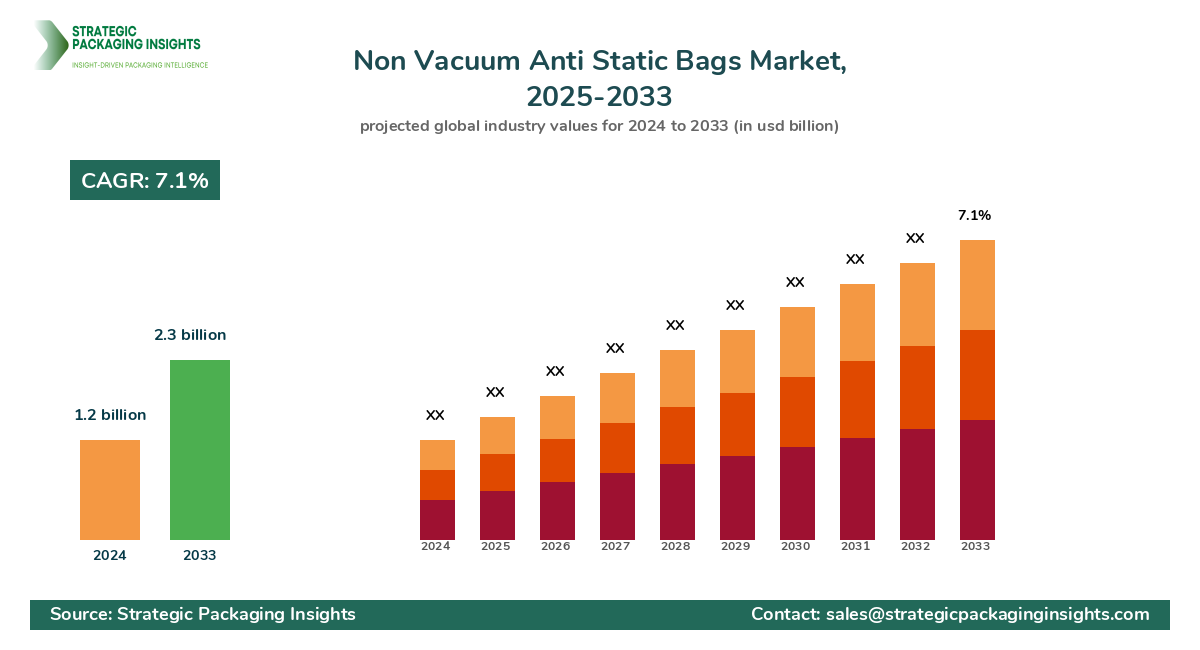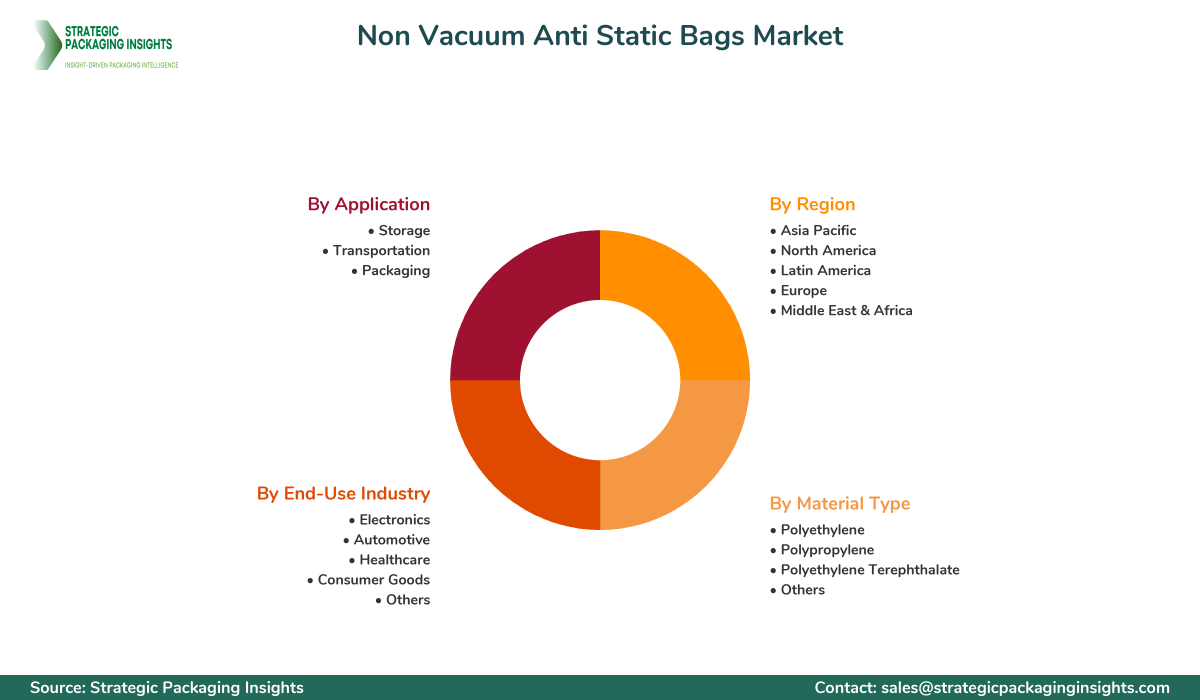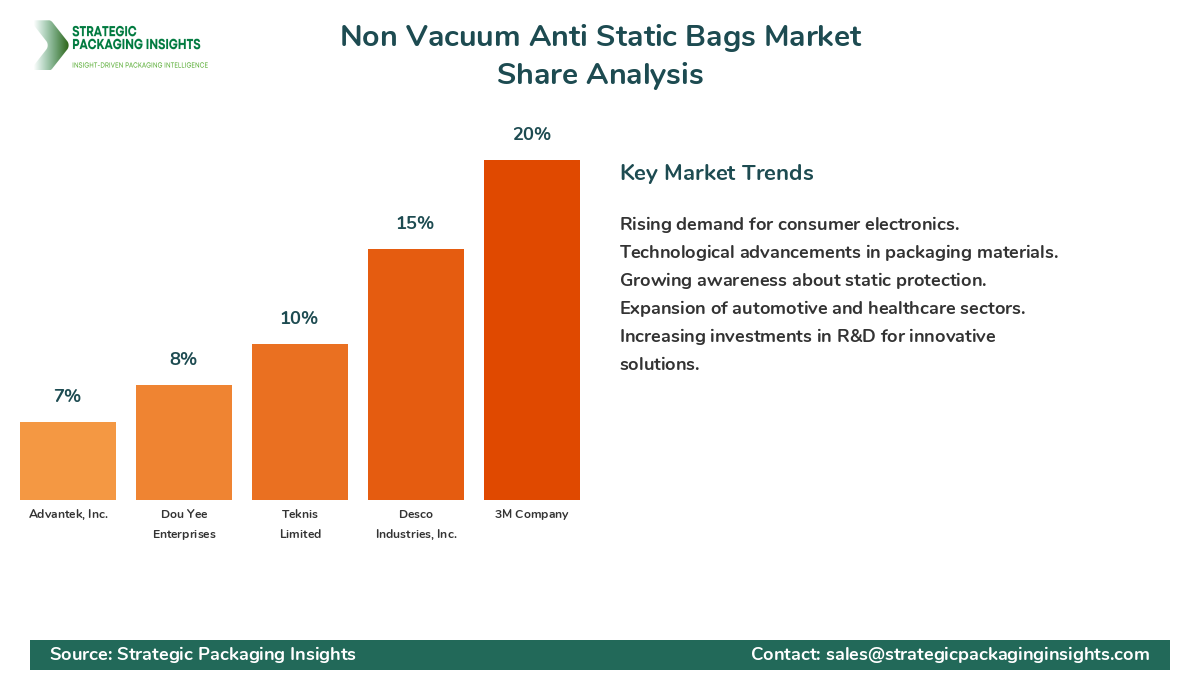- Home
- Packaging Products
- Non Vacuum Anti Static Bags Market Size, Future Growth and Forecast 2033
Non Vacuum Anti Static Bags Market Size, Future Growth and Forecast 2033
Non Vacuum Anti Static Bags Market Segments - by Material Type (Polyethylene, Polypropylene, Polyethylene Terephthalate, Others), End-Use Industry (Electronics, Automotive, Healthcare, Consumer Goods, Others), Application (Storage, Transportation, Packaging), and Region (Asia Pacific, North America, Latin America, Europe, and Middle East & Africa) - Market Dynamics, Growth Opportunities, Strategic Drivers, and PESTLE Outlook (2025–2033)
Non Vacuum Anti Static Bags Market Outlook
The Non Vacuum Anti Static Bags market was valued at $1.2 billion in 2024 and is projected to reach $2.3 billion by 2033, growing at a CAGR of 7.1% during the forecast period 2025-2033. This market is driven by the increasing demand for electronic components and devices that require protection from static electricity. The rise in consumer electronics, coupled with the growth of the automotive and healthcare sectors, has significantly contributed to the market's expansion. Additionally, the growing awareness about the importance of static protection in sensitive electronic components is further propelling the demand for non-vacuum anti-static bags. The market is also benefiting from technological advancements in packaging materials, which enhance the durability and effectiveness of these bags.
Report Scope
| Attributes | Details |
| Report Title | Non Vacuum Anti Static Bags Market Size, Future Growth and Forecast 2033 |
| Base Year | 2024 |
| Historic Data | 2017-2023 |
| Forecast Period | 2025-2033 |
| Number of Pages | 247 |
| Material Type | Polyethylene, Polypropylene, Polyethylene Terephthalate, Others |
| End-Use Industry | Electronics, Automotive, Healthcare, Consumer Goods, Others |
| Application | Storage, Transportation, Packaging |
| Region | Asia Pacific, North America, Latin America, Europe, Middle East & Africa |
| Customization Available | Yes* |
Key Highlights Non Vacuum Anti Static Bags Market

- Increasing demand for consumer electronics is a major driver for the market.
- Technological advancements in packaging materials are enhancing product effectiveness.
- Growing awareness about static protection in electronic components.
- Expansion of the automotive and healthcare sectors is boosting demand.
- Asia Pacific is the fastest-growing region in the market.
- Polyethylene is the most widely used material type in the market.
- Storage and transportation applications dominate the market.
- Rising investments in R&D for innovative packaging solutions.
- Stringent regulations regarding electronic component safety are influencing market dynamics.
Competitive Intelligence
The Non Vacuum Anti Static Bags market is highly competitive, with several key players striving to gain a larger market share. Top companies include 3M Company, Desco Industries, Inc., Teknis Limited, Dou Yee Enterprises, and Advantek, Inc. These companies are focusing on expanding their product portfolios and enhancing their geographic reach to cater to a broader customer base. 3M Company, for instance, is known for its innovative approach and strong R&D capabilities, which have helped it maintain a leading position in the market. Desco Industries, Inc. has a robust distribution network and a strong focus on customer retention, which has contributed to its steady revenue growth. Teknis Limited is gaining ground with its focus on high-quality materials and customer-centric solutions. Dou Yee Enterprises and Advantek, Inc. are also expanding their presence in emerging markets, leveraging their strong product offerings and strategic partnerships.
Regional Market Intelligence of Non Vacuum Anti Static Bags
In terms of regional market size, North America holds a significant share, valued at $400 million in 2024, and is expected to grow steadily due to the presence of major electronics manufacturers and stringent safety regulations. Europe follows closely, with a market size of $350 million, driven by the automotive and healthcare sectors. The Asia-Pacific region is the fastest-growing, with a market size of $300 million, expected to reach $700 million by 2033, due to rapid industrialization and increasing demand for consumer electronics. Latin America and the Middle East & Africa have smaller market sizes, valued at $100 million and $50 million respectively, but are witnessing growth due to expanding manufacturing sectors and increasing awareness about static protection.
Top Countries Insights in Non Vacuum Anti Static Bags
The United States leads the market with a size of $350 million and a CAGR of 6%, driven by technological advancements and a strong electronics industry. China follows with a market size of $250 million and a CAGR of 10%, fueled by rapid industrialization and increasing consumer electronics demand. Germany, with a market size of $150 million and a CAGR of 5%, benefits from its robust automotive sector. Japan, valued at $100 million with a CAGR of 7%, is driven by innovation in electronics manufacturing. India, with a market size of $80 million and a CAGR of 12%, is experiencing growth due to rising investments in the electronics sector and increasing awareness about static protection.
Non Vacuum Anti Static Bags Market Segments Insights

Material Type Analysis
Polyethylene is the most widely used material type in the Non Vacuum Anti Static Bags market, owing to its cost-effectiveness and excellent protective properties. It is favored for its durability and ability to provide a reliable barrier against static electricity. The demand for polyethylene bags is particularly high in the electronics and consumer goods industries, where cost and performance are critical factors. Polypropylene and polyethylene terephthalate are also gaining traction, with manufacturers focusing on enhancing their properties to cater to specific industry needs. The development of biodegradable and eco-friendly materials is a growing trend, driven by increasing environmental concerns and regulatory pressures.
End-Use Industry Analysis
The electronics industry is the largest end-use segment for Non Vacuum Anti Static Bags, driven by the need to protect sensitive components from static damage. The automotive sector is also a significant contributor, with the increasing integration of electronic systems in vehicles. The healthcare industry is witnessing growing demand for anti-static packaging solutions, particularly for medical devices and equipment. Consumer goods, including household appliances and personal electronics, represent another key segment, with manufacturers seeking reliable packaging solutions to enhance product safety and longevity. The market is characterized by a diverse range of applications, each with specific requirements and challenges.
Application Analysis
Storage and transportation are the primary applications for Non Vacuum Anti Static Bags, accounting for a significant share of the market. These applications are driven by the need to protect electronic components during handling and transit, ensuring their integrity and functionality. Packaging is another critical application, with manufacturers seeking innovative solutions to enhance product presentation and protection. The demand for customized packaging solutions is increasing, with companies focusing on developing tailored products to meet specific customer needs. The market is also witnessing a shift towards sustainable packaging solutions, driven by environmental concerns and regulatory pressures.
The market share distribution in the Non Vacuum Anti Static Bags market is characterized by the dominance of a few key players, with 3M Company and Desco Industries, Inc. leading the pack. These companies have established strong brand recognition and customer loyalty, enabling them to maintain a significant share of the market. Teknis Limited and Dou Yee Enterprises are gaining ground, leveraging their focus on innovation and customer-centric solutions. Advantek, Inc. is also expanding its market presence, driven by strategic partnerships and a strong product portfolio. The competitive landscape is dynamic, with companies focusing on enhancing their product offerings and expanding their geographic reach to gain a competitive edge. The market share distribution affects pricing strategies, with leading players able to command premium prices due to their strong brand reputation and product quality. Innovation and partnerships are key differentiators, with companies investing in R&D to develop advanced packaging solutions and forge strategic alliances to enhance their market position.
Non Vacuum Anti Static Bags Market Segments
The Non Vacuum Anti Static Bags market has been segmented on the basis of
Material Type
- Polyethylene
- Polypropylene
- Polyethylene Terephthalate
- Others
End-Use Industry
- Electronics
- Automotive
- Healthcare
- Consumer Goods
- Others
Application
- Storage
- Transportation
- Packaging
Region
- Asia Pacific
- North America
- Latin America
- Europe
- Middle East & Africa
Primary Interview Insights
What are the main drivers for the Non Vacuum Anti Static Bags market?
Which regions are experiencing the fastest growth in this market?
What challenges does the market face?
How are companies differentiating themselves in this market?
What role does R&D play in this market?
Latest Reports

The resealable films market was valued at $4.5 billion in 2024 and is projected to reach $7.8 billion by 2033, growing at a CAGR of 6.2% during the forecast period 2025–2033.

The foodservice disposables market was valued at $23.5 billion in 2024 and is projected to reach $37.8 billion by 2033, growing at a CAGR of 5.4% during the forecast period 2025–2033.

The Kraft Paper market was valued at $17.5 billion in 2024 and is projected to reach $25.3 billion by 2033, growing at a CAGR of 4.2% during the forecast period 2025–2033.

The adhesive tape films market was valued at $62 billion in 2024 and is projected to reach $95 billion by 2033, growing at a CAGR of 4.8% during the forecast period 2025–2033.

The advanced chip packaging market was valued at $35 billion in 2024 and is projected to reach $65 billion by 2033, growing at a CAGR of 7.5% during the forecast period 2025–2033.

The oxo-biodegradable plastic packaging market was valued at $3.2 billion in 2024 and is projected to reach $5.6 billion by 2033, growing at a CAGR of 6.5% during the forecast period 2025–2033.

The bakery cases market was valued at $1.2 billion in 2024 and is projected to reach $2.1 billion by 2033, growing at a CAGR of 6.5% during the forecast period 2025–2033.

The food and beverage packaging market was valued at $305 billion in 2024 and is projected to reach $450 billion by 2033, growing at a CAGR of 4.5% during the forecast period 2025–2033.

The pharmaceutical contract packaging market was valued at $10.5 billion in 2024 and is projected to reach $18.2 billion by 2033, growing at a CAGR of 6.5% during the forecast period 2025–2033.

The industrial textile chemicals market was valued at $28.47 billion in 2024 and is projected to reach $39.52 billion by 2033, growing at a CAGR of 3.71% during the forecast period 2025–2033.

The Single Zero Aluminum Foil market was valued at $5.2 billion in 2024 and is projected to reach $8.7 billion by 2033, growing at a CAGR of 5.8% during the forecast period 2025–2033.

The Packaging Accessories market was valued at $72.5 billion in 2024 and is projected to reach $117.38 billion by 2033, growing at a CAGR of 5.50% during the forecast period 2025–2033.

The Packaging Tensioner market was valued at $1.2 billion in 2024 and is projected to reach $2.3 billion by 2033, growing at a CAGR of 6.5% during the forecast period 2025–2033.

The Ethical Label market was valued at $1.5 billion in 2024 and is projected to reach $3.2 billion by 2033, growing at a CAGR of 8.5% during the forecast period 2025–2033.

The Hot Melt Glue Labeler market was valued at $1.2 billion in 2024 and is projected to reach $2.3 billion by 2033, growing at a CAGR of 6.5% during the forecast period 2025–2033.

The Automatic Labeling Machine market was valued at $2.5 billion in 2024 and is projected to reach $4.8 billion by 2033, growing at a CAGR of 7.2% during the forecast period 2025–2033.

The Smart Container market was valued at $2.5 billion in 2024 and is projected to reach $8.7 billion by 2033, growing at a CAGR of 14.5% during the forecast period 2025–2033.

The self-heating food packaging market was valued at $4.5 billion in 2024 and is projected to reach $7.8 billion by 2033, growing at a CAGR of 6.2% during the forecast period 2025–2033.

The Aluminium Foil Packaging market was valued at $25 billion in 2024 and is projected to reach $40 billion by 2033, growing at a CAGR of 5.5% during the forecast period 2025–2033.

The plastic card market was valued at $27.5 billion in 2024 and is projected to reach $40.2 billion by 2033, growing at a CAGR of 4.3% during the forecast period 2025–2033.

The print label market was valued at $39.5 billion in 2024 and is projected to reach $59.2 billion by 2033, growing at a CAGR of 4.5% during the forecast period 2025–2033.

The holographic film market was valued at $2.5 billion in 2024 and is projected to reach $4.8 billion by 2033, growing at a CAGR of 7.2% during the forecast period 2025–2033.

The clamshell labelling machines market was valued at $1.2 billion in 2024 and is projected to reach $2.3 billion by 2033, growing at a CAGR of 6.5% during the forecast period 2025–2033.

The consumer packaging market was valued at $1.2 trillion in 2024 and is projected to reach $1.8 trillion by 2033, growing at a CAGR of 4.5% during the forecast period 2025–2033.

The self-adhesive label market was valued at $40 billion in 2024 and is projected to reach $60 billion by 2033, growing at a CAGR of 4.5% during the forecast period 2025–2033.

The resealable films market was valued at $4.5 billion in 2024 and is projected to reach $7.8 billion by 2033, growing at a CAGR of 6.2% during the forecast period 2025–2033.

The foodservice disposables market was valued at $23.5 billion in 2024 and is projected to reach $37.8 billion by 2033, growing at a CAGR of 5.4% during the forecast period 2025–2033.

The Kraft Paper market was valued at $17.5 billion in 2024 and is projected to reach $25.3 billion by 2033, growing at a CAGR of 4.2% during the forecast period 2025–2033.

The adhesive tape films market was valued at $62 billion in 2024 and is projected to reach $95 billion by 2033, growing at a CAGR of 4.8% during the forecast period 2025–2033.

The advanced chip packaging market was valued at $35 billion in 2024 and is projected to reach $65 billion by 2033, growing at a CAGR of 7.5% during the forecast period 2025–2033.

The oxo-biodegradable plastic packaging market was valued at $3.2 billion in 2024 and is projected to reach $5.6 billion by 2033, growing at a CAGR of 6.5% during the forecast period 2025–2033.

The bakery cases market was valued at $1.2 billion in 2024 and is projected to reach $2.1 billion by 2033, growing at a CAGR of 6.5% during the forecast period 2025–2033.

The food and beverage packaging market was valued at $305 billion in 2024 and is projected to reach $450 billion by 2033, growing at a CAGR of 4.5% during the forecast period 2025–2033.

The pharmaceutical contract packaging market was valued at $10.5 billion in 2024 and is projected to reach $18.2 billion by 2033, growing at a CAGR of 6.5% during the forecast period 2025–2033.

The industrial textile chemicals market was valued at $28.47 billion in 2024 and is projected to reach $39.52 billion by 2033, growing at a CAGR of 3.71% during the forecast period 2025–2033.

The Single Zero Aluminum Foil market was valued at $5.2 billion in 2024 and is projected to reach $8.7 billion by 2033, growing at a CAGR of 5.8% during the forecast period 2025–2033.

The Packaging Accessories market was valued at $72.5 billion in 2024 and is projected to reach $117.38 billion by 2033, growing at a CAGR of 5.50% during the forecast period 2025–2033.

The Packaging Tensioner market was valued at $1.2 billion in 2024 and is projected to reach $2.3 billion by 2033, growing at a CAGR of 6.5% during the forecast period 2025–2033.

The Ethical Label market was valued at $1.5 billion in 2024 and is projected to reach $3.2 billion by 2033, growing at a CAGR of 8.5% during the forecast period 2025–2033.

The Hot Melt Glue Labeler market was valued at $1.2 billion in 2024 and is projected to reach $2.3 billion by 2033, growing at a CAGR of 6.5% during the forecast period 2025–2033.

The Automatic Labeling Machine market was valued at $2.5 billion in 2024 and is projected to reach $4.8 billion by 2033, growing at a CAGR of 7.2% during the forecast period 2025–2033.

The Smart Container market was valued at $2.5 billion in 2024 and is projected to reach $8.7 billion by 2033, growing at a CAGR of 14.5% during the forecast period 2025–2033.

The self-heating food packaging market was valued at $4.5 billion in 2024 and is projected to reach $7.8 billion by 2033, growing at a CAGR of 6.2% during the forecast period 2025–2033.

The Aluminium Foil Packaging market was valued at $25 billion in 2024 and is projected to reach $40 billion by 2033, growing at a CAGR of 5.5% during the forecast period 2025–2033.

The plastic card market was valued at $27.5 billion in 2024 and is projected to reach $40.2 billion by 2033, growing at a CAGR of 4.3% during the forecast period 2025–2033.

The print label market was valued at $39.5 billion in 2024 and is projected to reach $59.2 billion by 2033, growing at a CAGR of 4.5% during the forecast period 2025–2033.

The holographic film market was valued at $2.5 billion in 2024 and is projected to reach $4.8 billion by 2033, growing at a CAGR of 7.2% during the forecast period 2025–2033.

The clamshell labelling machines market was valued at $1.2 billion in 2024 and is projected to reach $2.3 billion by 2033, growing at a CAGR of 6.5% during the forecast period 2025–2033.

The consumer packaging market was valued at $1.2 trillion in 2024 and is projected to reach $1.8 trillion by 2033, growing at a CAGR of 4.5% during the forecast period 2025–2033.

The self-adhesive label market was valued at $40 billion in 2024 and is projected to reach $60 billion by 2033, growing at a CAGR of 4.5% during the forecast period 2025–2033.
